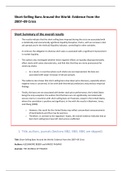Short-Selling Bans Around the World: Evidence from the
2007–09 Crisis
Short Summary of the overall results
- The results indicate that the short-selling bans imposed during the crisis are associated with
a statistically and economically significant liquidity disruption, that is, with an increase in bid-
ask spreads and in the Amihud illiquidity indicator, controlling for other variables.
- In contrast, the obligation to disclose short sales is associated with a significant improvement
in market liquidity.
- The authors also investigate whether these negative effects on liquidity disproportionately
affect stocks with some characteristics, and find that that they are more pronounced for
small-cap stocks.
o As a result, in countries where such stocks are overrepresented, the bans are
associated with larger increases in bid-ask spreads.
- The evidence also shows that short-selling bans slow down price discovery, especially where
negative news is concerned, in line with both theoretical predictions and previous empirical
findings
- Finally, the bans are not associated with better stock price performance, the United States
being the only exception: the authors find that bans are not significantly correlated with
excess returns in countries with short-selling bans on financials, except in the United States,
where the correlation is positive and significant, in line with the results in Boehmer, Jones,
and Zhang (2009).
o However, this result for the United States may reflect concomitant announcements
of bank bailouts and thus may be spurious.
o Therefore, in contrast to the regulators’ hopes, the overall evidence indicates that at
best short-selling bans have left stock prices unaffected.
1. Title, authors, journals (Sections IIIB2, IIIB3, IIIB4, are skipped)
Title: Short-Selling Bans Around the World: Evidence from the 2007–09 Crisis
Authors: ALESSANDRO BEBER and MARCO PAGANO
Journals: THE JOURNAL OF FINANCE
, 2. Research Question + underlying intuition
- The primary focus of the study is the effect of short-selling bans on market liquidity.
- The authors also investigate their effects on other dimensions of market performance
considered in the literature, such as price discovery and the level of stock prices.
The price discovery process (also called price discovery mechanism) is the process of
determining the price of an asset in the marketplace through the interactions of buyers and
sellers.
Naked short selling, or naked shorting, is the practice of short-selling a tradable asset of
any kind without first borrowing the security or ensuring that the security can be borrowed, as
is conventionally done in a short sale.
III. Market Liquidity
Hypothesis: In a setting where bid-ask spreads compensate dealers for their inventory holding costs,
a short-selling ban should widen bid-ask spreads: the inability to short the stock should impair
market makers’ inventory management, which is especially problematic in volatile market phases
such as the crisis period.
IV. Price Discovery
Hypothesis: By restraining trading by investors with negative fundamental information, a short-
selling ban should slow price discovery, and more so in bear markets.
V. Stock Prices
Hypothesis: The section examines whether the bans provided effective support for the prices of
financial stocks when benchmarked against exempt stocks.
3. Main methodology
I. The Setting
A. Liquidity
B. Speed of Price Discovery
C. Overpricing
II. Data and Method
III. Market Liquidity
A. Descriptive Evidence
B. Regression Analysis: Overall Liquidity Effect
B.1. Panel Regressions
B.2. Event Study Regressions
B.3. Endogeneity
B.4. Distinguishing between Ban Inceptions and Ban Lifts
, C. Regression Analysis: Differential Liquidity Effects
C.1. Size and Volatility
C.2. Optionable Stocks
C.3. Country of Listing
C.4. Cross-Listed Stocks
IV. Price Discovery
V. Stock Prices
VI. Conclusions
Methodology
- In assessing the impact of short-selling bans on liquidity, the authors take into account the
fact that bid-ask spreads may be affected by stock-specific characteristics.
o Hence, in the estimation they use stock-level fixed effects, and in some specifi-
cations they also control for return volatility, whose changes may affect bid-ask
spreads by changing the inventory risk of market makers, and for common changes
in liquidity by including day fixed effects, to take into account commonality in
liquidity.
o The latter is especially important in view of the fact that, during the crisis, increased
uncertainty and acute funding problems are likely to have reduced stock market
liquidity throughout the world.
I. The Setting
The analysis concerns the effects of short-selling bans on three variables:
1. Market liquidity,
2. Price discovery,
3. Stock overpricing
- Theoretical reasons and previous evidence cast doubt on the benefits of short-selling bans,
suggesting instead that they may reduce market liquidity and hinder price discovery, while
not necessarily supporting security prices.
- In this paper, the authors exploit the regulatory interventions around the world in 2008 and
2009 to shed light on the above issues:
o the flurry of short-selling bans generated an unprecedented wealth of data that can
be used to investigate their effects on market liquidity, on the speed of price
discovery, and on stock prices.





